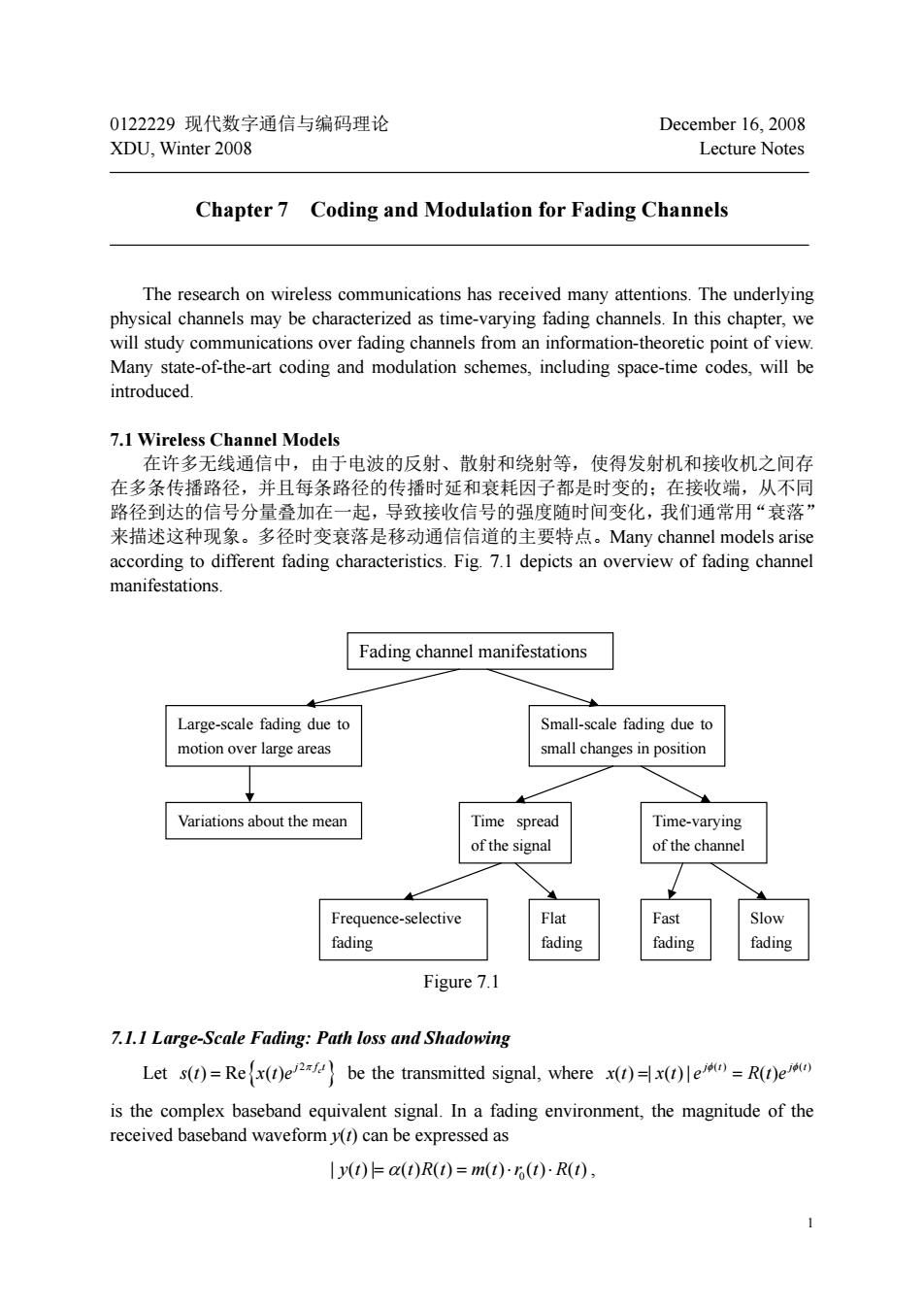正在加载图片...

0122229现代数字通信与编码理论 December 16,2008 XDU,Winter 2008 Lecture Notes Chapter 7 Coding and Modulation for Fading Channels physical channels may be characterized as time-varying fading channels.In this chapter,we will study communications over fading channels from an information-theoretic point of view. Many state-of-the-art coding and modulation schemes,including space-time codes,will be introduced. 7.1 Wireless Cha nne 1 Models 无线通信中,由于电波的反射、散射和绕射等,使得发射机和接收机之间有 在多条传播路径,并且每条路径的传播时延和衰耗因子都是时变的:在接收端,从不同 路径到达的信号分量叠加在一起,导致接收信号的强度随时间变化,我们通常用“衰落” 来描述这种现象。多径时变衰落是移动通信信道的主要特点。Many channel models arise or fading.Fi7.I depicts an overview of fading manifestations Fading channel manifestations Large-scale fading due to Small-scale fading due to motion over large areas small changes in position Variations about the mean Time spread Time-varying of the signal of the channel Frequence-selective fading ading ading Figure 7.1 7.1.1 Large-Scale Fading:Path loss and Shadowing Let s()=Rex()e be the transmitted signal,where x(t)x()e=R(e) is the complex baseband equivalent signal.In a fading environment,the magnitude of the received baseband waveform()can be expressed as |()Fa()R0=m)-()R() 1 0122229 现代数字通信与编码理论 December 16, 2008 XDU, Winter 2008 Lecture Notes Chapter 7 Coding and Modulation for Fading Channels The research on wireless communications has received many attentions. The underlying physical channels may be characterized as time-varying fading channels. In this chapter, we will study communications over fading channels from an information-theoretic point of view. Many state-of-the-art coding and modulation schemes, including space-time codes, will be introduced. 7.1 Wireless Channel Models 在许多无线通信中,由于电波的反射、散射和绕射等,使得发射机和接收机之间存 在多条传播路径,并且每条路径的传播时延和衰耗因子都是时变的;在接收端,从不同 路径到达的信号分量叠加在一起,导致接收信号的强度随时间变化,我们通常用“衰落” 来描述这种现象。多径时变衰落是移动通信信道的主要特点。Many channel models arise according to different fading characteristics. Fig. 7.1 depicts an overview of fading channel manifestations. Figure 7.1 7.1.1 Large-Scale Fading: Path loss and Shadowing Let 2 ( ) Re ( ) c j ft st xte be the transmitted signal, where () () ( ) | ( )| ( ) jt jt x t xt e Rte is the complex baseband equivalent signal. In a fading environment, the magnitude of the received baseband waveform y(t) can be expressed as 0 | ( )| ( ) ( ) ( ) ( ) ( ) y t tRt mt r t Rt , Fading channel manifestations Large-scale fading due to motion over large areas Small-scale fading due to small changes in position Variations about the mean Time spread of the signal Time-varying of the channel Frequence-selective fading Flat fading Fast fading Slow fading